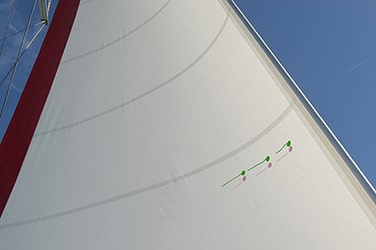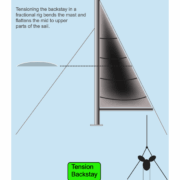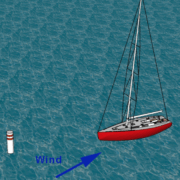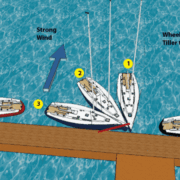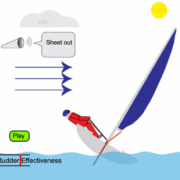Sailing in High Winds
High Wind Sailing
Animations embedded below – for best experience use Google Chrome Browser.
This week I did a practical Skipper Verification check out on one of our students. His initial comments to me were that he already knew how to sail but needed the rust blown out since he had not sailed for a few years and he also wanted to go through our Maneuvering Under Power practical training.
A cold front had come through that morning and thus the winds were cranking at 20 to 40 knots. This set up a perfect scenario for the above requirements.
My first comment on sailing in high winds is that mathematically, force on a sail is proportional to the square of the velocity. That is the difference between 5 knots and 10 knots is 4 times the force. But also look at this – the difference between 5 knots and 20 knots is 16 times. And the force between 5 knots to 40 knots is 64 times or hurricane strength is 256 times.
This means any imbalance on the helm to hold the boat in a straight line goes through the roof. The speed of water over the rudder accounts for some of the makeup required to counteract increased weather helm. If you double the water speed over the rudder, the rudder is 4 times more effective. But rarely do you get to quadruple the sailing speed of the boat so you get a diminishing return of rudder force combating the wind force on the sails.
All this means is that you’ve got to understand balancing the forces and what are the effects of each available sail control. One way is obvious and that is to reef the sails to reduce the area of the sails presented to the wind. But this is only linear. i.e. half the sail size = half the force. Quarter the sail size = quarter the force. Thus if you went from 5 knots wind speed to 20 knots and reefed the sails down to ½ then you still have 8 times the force on the sails. Still a lot!
The other balance thing to think about is the balance of the headsail and mainsail. In a nicely balanced boat, you have a little bit of weather helm. This means a tiller is pulled slightly to weather (windward) to keep the boat sailing in a straight line. If you center the tiller, the boat will round up. On a wheel, you have the wheel turned slightly downwind to stop the rounding up propensity – if you center the wheel the boat will round up into wind. Most people think this is solely for safety, while it works for safety, the greatest advantage is that with the rudder pointed slightly upwind you get a windward force component on the boat helping your boat climb to weather marks (a point upwind).
When you start changing forces by 8 to 16 times any perfect balance systems you think you have start to get out of whack quickly. For example, on our Beneteau 373, anything over 12 knots of wind, we begin to round up into the wind and full rudder over can not stop the round-up. i.e. there is too much weather helm. Not only are round-ups dangerous but the increased weather helm creates excessive drag slowing the boat and water speed over the rudder and thus reduces rudder effectiveness. Additionally, heeling also reduces the rudder area and thus effectiveness all the while you are trying to use the rudder to combat quadrupled wind force. Ahhh!
Therefore the first thing we do on the 373 is to reef the mainsail to shift the center of pressure forward which reduces the round-up propensity. The center of pressure moves forward because the center of the combined area of the sails presented to the wind is now further forward. This is good because the sail pressure force moving forward tends to act to less push the aft of the boat downwind.
Play this animation to understand what I’m talking about here. I used a floating coke bottle because you can easily relate to taking your finger and pushing on either end of the bottle and watching it turn in the water. When you push on the bottom of the coke bottle the bottle turns to windward. This is equivalent to a lot of force on the mainsail. To combat this you would turn and hold the rudder as if to turn the boat downwind – this creates pressure on the helm called weather helm. The tiller would be pointed to weather (wind).
When you push near the top of the bottle the bottle turns downwind. This is equivalent to a lot of force from the headsail. To combat this you would turn and hold the rudder as if to turn the boat upwind this creates pressure on the helm called lee helm. The tiller would be pointed to the lee.
Besides the importance of reefing to reduce sail area in both the main and headsail to try to gain back some balance, there are other things that you should be doing when sailing in high winds to reduce weather helm, reduce heeling, balance the sail plan and gain back some efficiencies.
Draft
Draft is the depth of curvature of the sail. The deepest part of the curve is called the position of the draft. Typically for a mainsail in best trim, this should be at about 40-50% away from the mast. As the wind picks up, the draft position shifts back as the sailcloth stretches.
For high winds then you want to reduce the draft (flatten the sail) and move it forward to 40 – 50% from the mast.
To reduce the draft depth (curvature of the sail) flatten it by tightening the outhaul. To move the draft forward, tighten the Cunningham.
On our 373 we don’t have a Cunningham, so with the mainsail depowered we tighten the halyard as much as possible as well as cranking heavy on the outhaul.
Note that the outhaul will only tighten the foot of the sail. The mid to upper area of the sail is not affected much by the outhaul. Thus to flatten the mid to upper section of the mainsail on fractional rigged yachts tighten the backstay. This bends the mast and shifts the midsection of the sail forward and thus tightening (flattening) the midsection of the sail. Fractional rigged yachts are where the forestay does not connect to the top of the mast, rather it is connected a fraction of the way down. For this reason, most racing boats are fractionally rigged with backstay tensioners.
Our 373 does not have a backstay tensioner as it is not a fractional rig (the forestay goes all the way to the top of the mast).
A few other tricks we used was to twist out the top of the sail by easing the mainsheet. This decreases sail power aloft and thus heel. We also depowered the lower part of the sail by easing the traveler to leeward which acts to move the center of pressure of the sail plan forward and thus decrease weather helm.
With all the above tricks we were able to sail the boat in this frontal wind system quite effectively. However, we certainly got knocked around with the many wind bullets coming over the cliffs and down onto the lake. I’d say we more than shook the rust out of our check-out sailor. He handled himself fine and thus passed the Verified Skipper Proficiency on his NauticEd Sailing Certification.
If you want to really sail like a pro and fly your sails with maximum efficiency, our sail trim course is a must.

Sail Trim Course

